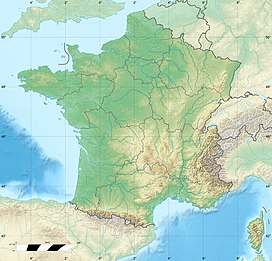Mer de Glace
| Mer de Glace | |
|---|---|
| Sea of Ice | |
 |
|
|
Mer de Glace located in France Map
|
|
| Location | Northern slopes of the Mont Blanc massif |
| Coordinates | 45°54′58″N 6°56′14″E / 45.91611°N 6.93722°ECoordinates: 45°54′58″N 6°56′14″E / 45.91611°N 6.93722°E |
| Length | 7 km (4.3 mi) |
The Mer de Glace is a valley glacier located on the northern slopes of the Mont Blanc massif, in the French Alps. It is 5.5 kilometres (3.4 mi) long and 200 metres (660 ft) deep but, when all its tributary glaciers are taken into account, it can be regarded as the longest and largest glacier in France, and the second longest in the Alps after the Aletsch Glacier.
I can no otherwise convey to you an image of this body of ice, broken into irregular ridges and deep chasms than by comparing it to waves instantaneously frozen in the midst of a violent storm.
In its strictest sense, the Mer de Glace can be considered as originating at an elevation of 2,100 metres (6,900 ft), just north of the Aiguille du Tacul, where it is formed by the confluence of the Glacier de Leschaux and the Glacier du Tacul. The former is fed by the Glacier du Talefre, whilst the latter is, in turn, fed by the Glacier des Periardes, the vast Glacier du Géant and the broad icefields of the Vallee Blanche. The Glacier du Tacul supplies much more ice than the Glacier de Leschaux.
However, if the Mer de Glace is considered in its broadest sense (i.e. from source to tongue), it is a compound valley glacier, gaining ice from snowfields that cover the heights directly north of Mont Blanc at an altitude of around 4,000 metres. It flows for a total distance of 12 kilometres, covering an area of 32 square kilometres in the central third of the Mont Blanc massif.
From the Aiguille du Tacul, the Mer de Glace flows north-north-west between Aiguille du Moine on the east and Trélaporte on the west. It descends below Montenvers, at which point it is approximately 0.5 km wide, and descends to approximately 1,500 metres (4,900 ft). The glacier was once easily visible from Chamonix but has been shrinking backwards, and is now barely visible from below. The surface topography of the Mer de Glace changed very little during the first third of the 20th century, but from 1939 to 2001 the surface of the glacier has lowered an average of 30 cm each year, corresponding to an equivalent loss of 700 million cubic metres of water.
The glacier lies above the Chamonix valley, and was the first place in the region to have a ready-made tourist attraction.
Like all glaciers, the Mer de Glace is in balance between two phenomena: accumulation, notably due to winter snowfall, and ablation, essentially due to summer melting. The Mer de Glace flows continuously under the effect of its own weight, causing crevasses, seracs or pockets of water to form, depending on the terrain over which it moves. Its speed, although not perceptible to the naked eye, is considerable. From more than 120 metres (390 ft) a year in its upper part, the Mer de Glace moves about 90 metres (300 ft) per year in the region of Montenvers, which is about one centimetre per hour.. The pressure within the ice is known to reach at least 30 atmospheres.
...
Wikipedia

